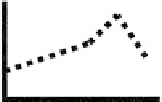Agriculture Reference
In-Depth Information
Table 5.1.
Hypotheses relating to diversity-function relationships.
Stylized diversity(x)-
function(y) relationship
Hypothesis
Basis
References
a
Redundancy
As long as all functional groups are
represented, system functioning is
independent of diversity
Lawton and
Brown, 1994
Rivet
All species make a significant contribution
to function and that a decrease in diversity
leads to a progressive decline in function
Lawton,
1994
Predictable
change
Change in diversity will result in an
alteration in function, which is predictable
given a prioriknowledge of the trophic
structure, biomass and principal
relationships between the biotic
components within a system
Mikola and
Setälä, 1998
Idiosyncratic
Changes in diversity will result in
changes in function, but the direction and
magnitude of any response are inherently
unpredictable
Lawton,
1994
Gas box
The biota act as an averaging engine
by-passing the ecological hierarchy; function
is considered as an integrated process
Andrén
et al., 1999
a
See Mikola and Setälä (1998) for further general discussion.
Initial research claimed to demonstrate benefits to ecosystem function
from higher biodiversity (Naeem
et al
., 1994; Tilman and Downing 1994;
Tilman
et al
., 1997). However, there is a growing body of experimental
evidence that the functional characteristics of component species are at
least as important as the number of species
per se
for maintaining critical
ecosystem processes (Grime, 1997; Wardle
et al
., 1997; Bardgett and
Shine, 1999). However, it is not known how much biodiversity is needed
to ensure continuance of specific soil functions. There is currently little
published experimental data which rigorously tests these four hypotheses
in below-ground systems, and research from the perspective of soil OM
dynamics is particularly sparse.















Search WWH ::

Custom Search